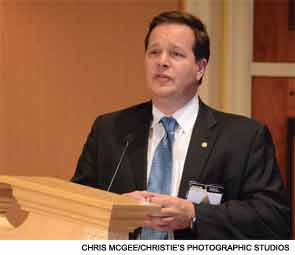
Mosher Award
Cochlear implantation to the lateral wall using the round window or the extended round window as the entry point produced the best results in a longitudinal study. The study, presented by George Wanna, MD, assistant professor of otolaryngology-head and neck surgery at Vanderbilt University Medical Center in Nashville, won this year’s Mosher Award for excellence among Triological Society candidate theses on clinical research. The study, which enrolled 100 patients who received 116 total implants, examined the location of the implant, the entryway used, and the extent to which the implant was inserted into the scala tympani. More than 90% of the 35 round window (RW) insertions and approximately 85% of the extended round window (ERW) insertions were determined to be fully inserted into the scala tympani. The difference between the ERW and RW results and the cochleostomy results—about a 35% full insertion rate —was statistically significant (p<0.001). Of the 47 lateral wall implants, 36 were performed using RW or ERW. All of the 16 lateral wall, round window cases were found to be fully inserted into the scala tympani. All but one of the 20 lateral wall, extended round window insertions were found to be fully inserted, but only a little more than 60% of the lateral wall implants using the cochleostomy approach were fully inserted, a significant difference (p=0.009). The perimodiolar (PM) implants did not achieve full scala tympani insertion at this rate. Among the 19 PM-RW cases, a little more than 80% achieved full insertion. Of 23 PM-ERW cases, fewer than 80% were determined to be fully inserted. Of the 27 PM-cochleostomy cases, fewer than 30% were fully inserted. Hearing was better among those with full scala tympani insertion, as expected, on all three tests (the consonant nucleus consonant, the hearing in noise test, and the AzBio sentence test). “We do recommend the use of the lateral wall implantation via a round window insertion or extended round window insertion,” Dr. Wanna said. “This will minimize trauma, optimize the hearing outcome, and optimize the full scala tympani insertion.”

Fowler Award
Scientists are making headway in refining the methods for getting hair cells on the organ of Corti in the inner ear to regenerate. The discovery of a new, potentially more powerful way of delivering a gene that promotes regrowth of these hair cells was recognized with this year’s Fowler Award, honoring excellence among this year’s Triological Society theses on basic science. The work, led by Hinrich Staecker, MD, PhD, professor of otolaryngology-head and neck surgery at the University of Kansas Medical Center in Kansas City, involves the pursuit of the optimal vectors with which to deliver the Atoh1 or Math1 gene, which was discovered in 1999 to be the genetic switch controlling the development of auditory vestibular hair cells. The human version of Atoh1 is Hath1. The gene is delivered on adenoviruses stripped of the genes that cause disease. When inserted, the adenovirus binds to the cell of interest and deposits its DNA, and protein is made, changing the behavior of the cell. Dr. Staecker’s work first focused on the commonly used Ad5 vector, which has a very good track record in human trials, along with the “promoter” GFAP protein that is meant to cause the gene of interest to be expressed only in supporting cells. Initial trials were promising, but researchers wanted to improve the performance of the vector by modifying it. They stripped it of its binding capacity to its different targets and found that the vector was still not targeting the desired cells in as direct a manner as they wanted. “There are alternate mechanisms, that we were never able to identify, that allow these vectors to be taken into the cells,” Dr. Staecker said. So they went looking for a better vector, examining several different species with different binding characteristics. They found, through in vitro experiments, that the vector Ad28 seemed to work best. “Ad28, when we really look at it, appears to be specific to supporting cells,” he said. In a 2011 paper, Dr. Staecker and his lab tested the vector’s performance in mice with auditory vestibular hair loss caused by a toxin they were fed (Gene Ther. 2011;18:884-890). After a 10-day recovery period, they were injected with various doses of the new Ad28-based vector, and their balance on a rotating rod was measured. They found a dose-specific recovery at four months, with the highest-dose vector leading to the greatest amount of recovery. “We now have two constructs, an Ad5-based construct and an Ad28-based construct, in which we can effectively regenerate hair cells and restore function,” Dr. Staecker said. A human trial of Ad5 has just been approved. Dr. Staecker said his lab is working on a head-to-head comparison of Ad5 and Ad28 to see whether it would be worth pursuing pre-clinical work on Ad28 for human trials.
Honorable Mentions
In addition to the Mosher and Fowler Awards, three Honorable Mention Awards were conferred on Howard W. Francis, MD, of Johns Hopkins University in Baltimore, Kenneth H. Lee, MD, PhD, of Children¹s Medical Center in Plano, Texas, and Andrew R. Scott, MD of Tufts Medical Center in Boston.
Leave a Reply